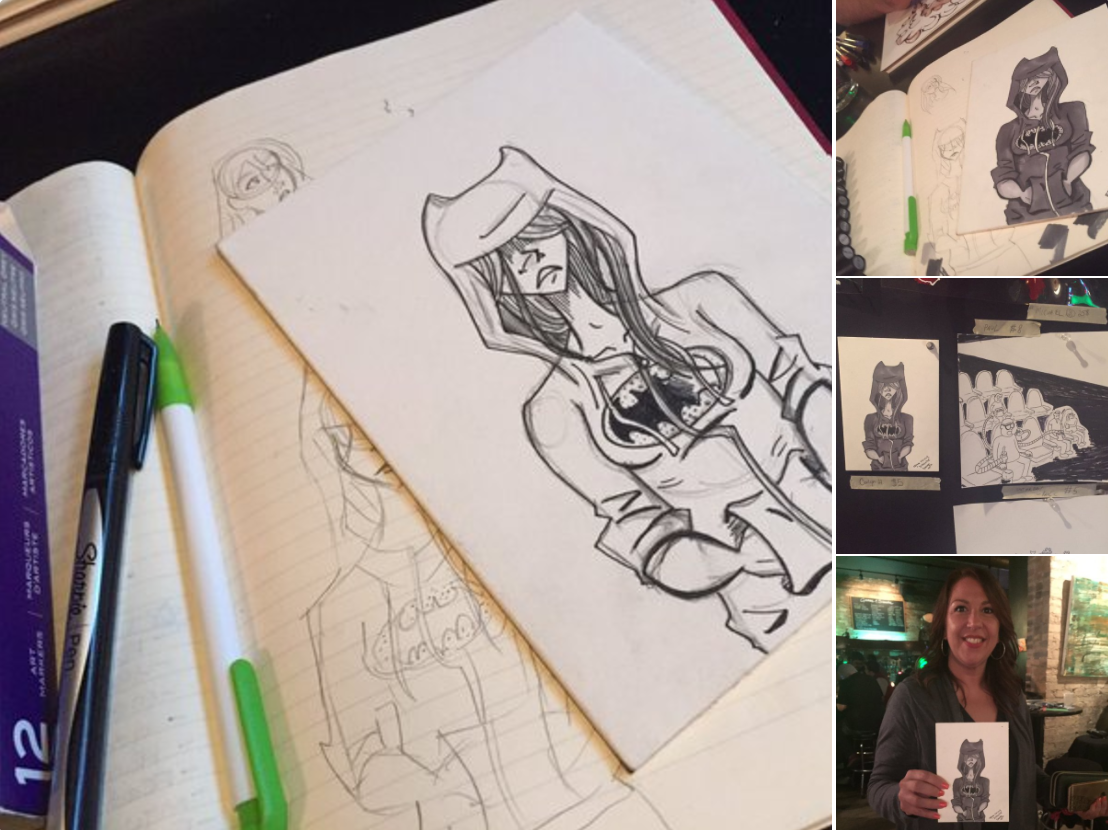When I first found out that drink and draws existed, my mind was blown. But drink and draws haven’t just saved me from the FOMO that introverted nights staying in and drawing caused me – they’ve also taught me not to undervalue my own work. At one particular drink and draw, there was a board where artists could pin their work on to sell. I decided to go for it. I slapped a $5 sticker on my drawing, pinned it up, and mentally prepared myself for it to be the last thing left on the board that night. But to my surprise, it sold!
I was over the moon, but when I told my friends about it, the first reaction I kept getting was: “You only charged $5?” At the time, I didn’t care about the money. I didn’t think people were going to look at my drawing, let alone buy it. But it started to get to me: why hadn’t I charged more than a can of PBR for my art?
At the end of the day, it wasn’t a money issue; it was a confidence issue. Because underselling our work isn’t just underselling a design – it’s underselling ourselves.

It’s far too easy for us as artists and creatives to fall into the “Imposter Syndrome” trap when pricing our work; the feeling that despite your talent, you don’t deserve your success or the price we’re charging for our art, and it’s only a matter of time before someone finds you out as a phony.
And in that way, underselling our products can actually be self-protective. Forbes reported that women tie self-esteem to price, which I speculate is the case for many creatives across genders. Underselling yourself and your work becomes an antidote for creative anxiety and fear of rejection by becoming a self-fulfilling prophecy; we low-ball our prices to give customers less faith in the product’s worth (linkedin), and they don’t buy it (think about when you see a generic brand medication and a branded medication; even when they do the same thing, we perceive the more expensive one as more effective.) And this is…safe. After all, it hurts way less to not sell something at a low price than to not sell something at a higher price and think, “oh, people don’t think this is worth what I think it’s worth…”
But that’s the paradox of making a business out of our own work: we are our own worst judge. People pay for value, and if that little voice in our head keeps telling us that we’re not worth as much as we actually are? It prevents us from helping others to see the value in our work…like the customer who bought my piece at the drink and draw. You built your talent, you put in the work to create your art – you deserve to make money off of it when you sell it.
So how do we combat this (besides just charging a little more)? Here are a few suggestions:
1.REMEMBER: YOU’RE RUNNING A BUSINESS
We do art because we love and enjoy it. But to sell your work successfully, art must also be treated like a business. You’re not setting prices just to please people – you’re setting prices so that you’ll make a profit. Which, in cases like this, makes it just a little easier to separate from creative anxiety and view pricing as a business choice. You put in work – if the design is quality, you should charge it as such.
2. Look at what similar artists are charging
Sometimes the best way of breaking out of our heads is to break out of looking at our own work. Check out what similar artists are charging for similar products and designs, and look at pricing averages across various online shops. Use their pricing as a baseline for your own and adjust!
3. Test different prices out
No shame in testing out a few different price levels to see what works! If you’re working in a platform wher you can adjust your price freely like you can with Artist Shops, test out how people react to adjusted prices and how higher/lower prices convert. If an item does just as well, or maybe even better, at a higher price, consider keeping it at that price.
4. weigh what you’ll be making
Look at how much the price of an item would leave you in actual profit. This helps you stay a little more objective as well, judging the price less on design and more on straight up math and profit. Artist Shops, for examples, have base fees to set your products at, and a handy chart that shows how to calculate your profit.
5. Embrace Failure, and realize your worth
You might undercharge a little at first and then find out you could’ve been making more. You might overshoot a little and charge a little too much. Figuring out your price range takes a little trial and error – embrace the mistakes and learn from them. And take pride in your work and in your worth. People value quality and will pay for it. It’s up to you to see the quality in your own art.
Illustrations done by the amazing Katie Lukes


